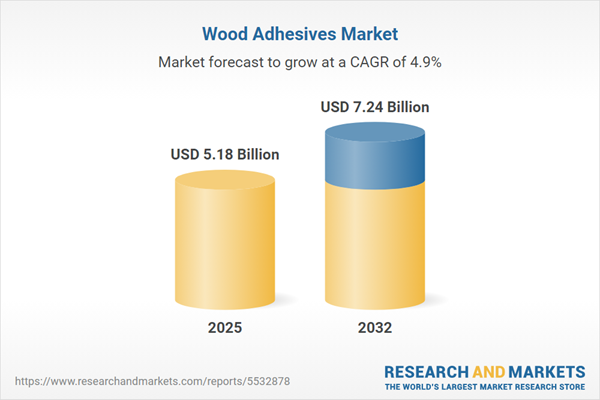Speak directly to the analyst to clarify any post sales queries you may have.
The wood adhesives market is rapidly evolving amid shifting regulatory landscapes, increased sustainability demands, and advancing technologies that shape manufacturing and supply chains worldwide. Senior decision-makers must navigate a sector where innovation, compliance, and operational agility determine strategic advantage across diverse industries and regions.
Market Snapshot: Growth Outlook in the Wood Adhesives Market
The Wood Adhesives Market grew from USD 4.94 billion in 2024 to USD 5.18 billion in 2025. It is expected to continue growing at a CAGR of 4.90%, reaching USD 7.24 billion by 2032. Global market expansion is shaped by the rising demand for durable, low-emission bonding solutions suitable for both traditional applications and new industrial segments. Key drivers include heightened regulatory requirements, increased emphasis on bio-based chemistries, and robust demand across construction, automotive, and packaging sectors.
Scope & Segmentation
- Resin Types: Acrylic, Epoxy, Melamine Formaldehyde, Phenolic, Polyurethane, PVA, Urea Formaldehyde
- Technology Platforms: Emulsion, Hot Melt, Pressure Sensitive, Solvent
- End-Use Industries: Automotive, Construction, Footwear, Furniture and Woodworking, Packaging
- Formulations: Reactive, Solvent Based, Water Based
- Physical Forms: Liquid, Solid
- Regions & Key Markets: Americas (North America: United States, Canada, Mexico; Latin America: Brazil, Argentina, Chile, Colombia, Peru), Europe, Middle East & Africa (Europe: United Kingdom, Germany, France, Russia, Italy, Spain, Netherlands, Sweden, Poland, Switzerland; Middle East: United Arab Emirates, Saudi Arabia, Qatar, Turkey, Israel; Africa: South Africa, Nigeria, Egypt, Kenya), Asia-Pacific (China, India, Japan, Australia, South Korea, Indonesia, Thailand, Malaysia, Singapore, Taiwan)
- Company Coverage: Henkel AG & Co. KGaA, H.B. Fuller Company, 3M Company, Arkema S.A., Sika AG, Ashland Global Holdings Inc., Dow Inc., Evonik Industries AG, RPM International Inc., Jowat SE
Key Takeaways for Senior Leaders
- Innovation in resin chemistry and adhesive technology is enabling product differentiation while supporting sustainability objectives across regulated markets.
- Manufacturers are accelerating investments in bio-based solutions and digital process monitoring to align with evolving compliance standards and reduce operational risks.
- Segment-specific trends reveal that automotive and construction stakeholders seek specialized adhesives for lightweight composites and engineered systems, while furniture and packaging focus on emissions and recyclability.
- Emerging entrants are leveraging modular platforms and niche chemistries, spurring established firms to pursue partnerships, capability enhancements, and portfolio diversification.
- Regional adaptation—such as tailored formulations in response to local climate or compliance requirements—is a critical success factor for global competitors.
- Strategic supply chain collaborations, including dual sourcing and scenario planning, are vital for mitigating volatility in raw material availability and pricing.
Tariff Impact and Supply Chain Shifts
Recent US tariff policies on select resins and precursor chemicals have driven notable changes in sourcing, production economics, and trade flows within the wood adhesives sector. Companies have responded by exploring domestic alternatives, expanding local production, and adjusting procurement models to absorb increased inbound costs or mitigate supply chain disruptions. Enhanced scenario planning and analytics capabilities support more accurate forecasting and strategic inventory management in this evolving environment.
Methodology & Data Sources
This report implements a robust methodology, combining in-depth interviews with industry executives, procurement leaders, and R&D managers, as well as regulatory and sustainability experts. Secondary research includes detailed reviews of trade association reports, proprietary white papers, technical journals, and patent filings. Analytical frameworks such as PESTEL and SWOT support comprehensive market and organizational assessments, validated by scenario analyses and rigorous peer review.
Why This Report Matters
- Gain strategic foresight into market dynamics to drive technology adoption, operational efficiency, and sustainable growth initiatives.
- Benchmark competitors’ innovation and supply chain strategies, identifying areas for possible collaboration or investment.
- Support strategic planning with reliable data, contextual trend analysis, and actionable recommendations for market entry or portfolio expansion.
Conclusion
The wood adhesives market is characterized by rapid innovation, complex regulatory trends, and region-specific growth opportunities. Informed action, supply chain resilience, and targeted R&D are key to maintaining a competitive edge as the global landscape continues to evolve.
Additional Product Information:
- Purchase of this report includes 1 year online access with quarterly updates.
- This report can be updated on request. Please contact our Customer Experience team using the Ask a Question widget on our website.
Table of Contents
3. Executive Summary
4. Market Overview
7. Cumulative Impact of Artificial Intelligence 2025
Companies Mentioned
The companies profiled in this Wood Adhesives market report include:- Henkel AG & Co. KGaA
- H.B. Fuller Company
- 3M Company
- Arkema S.A.
- Sika AG
- Ashland Global Holdings Inc.
- Dow Inc.
- Evonik Industries AG
- RPM International Inc.
- Jowat SE
Table Information
| Report Attribute | Details |
|---|---|
| No. of Pages | 187 |
| Published | October 2025 |
| Forecast Period | 2025 - 2032 |
| Estimated Market Value ( USD | $ 5.18 Billion |
| Forecasted Market Value ( USD | $ 7.24 Billion |
| Compound Annual Growth Rate | 4.9% |
| Regions Covered | Global |
| No. of Companies Mentioned | 11 |









